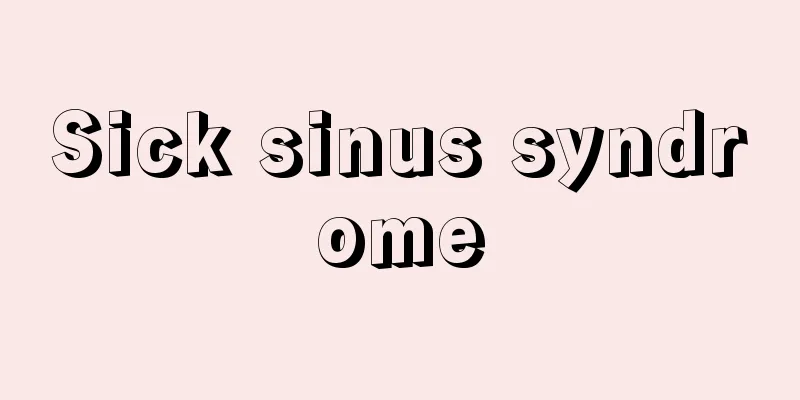Sick sinus syndrome

What is the disease? Sick sinus syndrome is mainly Electrocardiographically, it is classified into three groups as follows (Figure 23A, B, F). Group 1: Persistent with unknown cause Group 2: Sinus arrest or Group 3: Bradycardia-tachycardia syndrome (see below) In either case, it is a syndrome in which a decrease in the amount of blood pumped from the heart causes circulatory disorders in major organs. When the number of P waves reflecting atrial excitation that appear at regular intervals on an electrocardiogram is small, it is called sinus bradycardia, and when the P waves suddenly stop appearing, it is called sinus arrest (or sinoatrial block). What is the cause? This is caused by a decrease in the sinus node's ability to produce impulses or by impaired sinus node-to-atrium conduction. How symptoms manifestNormally, the heart beats about 60 to 100 times per minute, but the pulse rate is greatly affected by the situation the person is in. In sick sinus syndrome, the heart rate does not increase accordingly even when exercising or having a fever. There are also types in which the pulse suddenly stops and the heart stops functioning for a while. The brain, a major organ, is prone to ischemic symptoms, such as dizziness, lightheadedness, slurred speech, near-fainting, and fainting. Other symptoms include congestive heart failure, Testing and diagnosisOn the electrocardiogram, the number of waves (P waves) generated by excitation of the atria decreases. If the atria are not excited, electrical impulses are not transmitted to the ventricles, so the number of waves (QRS waves) on the electrocardiogram that indicate ventricular excitation also decreases. If the number of P waves is extremely low, impulses are naturally generated from stimulation centers located other than the sinus node. The electrical activity of the heart at this time is called escape rhythm. However, people who have been engaged in long-term intense training such as long-distance running may be completely asymptomatic even if their heart rate is below 40 beats per minute. If bradycardia is observed on the electrocardiogram and coincident symptoms such as cerebral ischemia are revealed, the diagnosis of sick sinus syndrome is confirmed. Treatment methods Drugs that increase the frequency of spontaneous sinus node excitation are used. Anticholinergic drugs (atropine sulfate), What to do if you notice an illnessFirst, if you notice symptoms of cerebral ischemia, lie down (or squat) to prevent hitting your head if you faint. If possible, count your pulse. If symptoms persist, immediately visit a hospital and undergo tests such as an electrocardiogram. If symptoms recur, see a cardiologist. Hirao Kenzo "> Figure 23. Various electrocardiogram waveforms Source: Houken “Sixth Edition Family Medicine Encyclopedia” Information about the Sixth Edition Family Medicine Encyclopedia |
どんな病気か 洞不全症候群とは、主に 心電図的には以下のように3つの群に分類されます(図23A、B、F)。 1群:原因不明の持続性 2群:洞停止または 3群:徐脈頻脈(ひんみゃく)症候群(後述) いずれにしろ、心臓から送り出される血液量の低下によって主要臓器の循環障害が起こる症候群です。心電図上で、心房興奮を反映するP波が規則正しい間隔で現れる数が少ないものを洞徐脈、P波が突然現れなくなる場合を洞停止(あるいは洞房ブロック)といいます。 原因は何か 洞結節の刺激を生み出す能力の低下、あるいは洞結節→心房間伝導の障害が原因です。 症状の現れ方通常、心臓は1分間に60~100回ほど脈を打ちますが、脈拍数は本人のおかれた状況に大きく左右されます。洞不全症候群では運動、発熱時などにも相応の心臓拍動数の上昇がみられません。また、突然脈が止まってしばらく心臓が活動しなくなるタイプもあります。 主要臓器の脳には虚血症状が出やすく、めまい、立ちくらみ、ろれつが回らない、失神しそうになる、失神などがあります。その他、うっ血性心不全、 検査と診断心電図上で、心房の興奮によって生ずる波(P波)の出現が少なくなります。心房が興奮しないと電気刺激が心室に伝わらないため、心室興奮を表す心電図上の波(QRS波)も減ります。P波の発生が極端に少ないと、洞結節以外の場所にある刺激中枢から自然に刺激が発生します。この時の心臓の電気的活動を補充調律といいます。 ただし、長期に長距離走などの激しいトレーニングを積んできた人では、心拍数が40/分以下であってもまったく無症状のことがあります。心電図上で徐脈があり、その時に一致して脳の虚血症状などの存在が明らかになれば、洞不全症候群の診断は確定します。 治療の方法 洞結節の自発的興奮の回数を増やす薬を使います。抗コリン薬(硫酸アトロピン)、 病気に気づいたらどうするまず、脳の虚血症状を自覚したら、失神した時に頭部を打撲するのを防ぐために横になって(あるいはしゃがんで)ください。できれば脈の数を数えてください。 症状が長引く場合は、すぐに病院を受診して心電図などの検査を受けます。また、繰り返すような場合には、循環器専門医の診察を受けてください。 平尾 見三 "> 図23 種々の心電図の波形 出典 法研「六訂版 家庭医学大全科」六訂版 家庭医学大全科について 情報 |
<<: Animals - Animals (English)
Recommend
Peritrichous crystal - Hosho
Also known as peritectic crystals. When crystals ...
dressing room
...In most cases, it is located at the back or re...
Ogura attached
〘Noun〙 A type of kamurizuke (a type of kanji for &...
Hayakawa [town] - Hayakawa
A town in Minamikoma County in western Yamanashi P...
Johannes VIII Palaelogus
1390‐1448 Byzantine Emperor. Reigned 1425-48. Son ...
Viracocha
A creator god in Inca mythology. He appeared on La...
Associated Container Transportation, Ltd.
…In addition to operating other shipping division...
Apuseni Mountains - Apusenisanchi
…A mountain range that is part of the Alpine-Hima...
Nicolas Joseph Cugnot
French military engineer. Born in Meuse, died in ...
Hiraga clan
In the Middle Ages, this samurai family held terri...
Tasman - Abel Janszoon Tasman
Dutch navigator and explorer. He served as a capt...
Dirk Brouwer
1902‐66 American astronomer. Born in the Netherlan...
Aitor
...Therefore, the Basque region, in a broad sense...
Date Kurabeokuni Kabuki - Date Kurabeokuni Kabuki
[1] Kabuki script. Historical piece. Collaborative...
Poster - poster (English spelling)
A piece of paper posted for the purpose of public...









